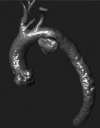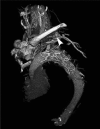Endovascular repair of a ruptured descending thoracic aortic aneurysm
- PMID: 16878637
- PMCID: PMC1524690
Endovascular repair of a ruptured descending thoracic aortic aneurysm
Abstract
Endovascular aneurysm repair has considerable potential advantages over the surgical approach as a treatment for thoracic aortic rupture, in part because open surgical repair of ruptured thoracic aortic aneurysms is associated with high mortality and morbidity rates. We describe the successful endovascular deployment of stent-grafts to repair a contained rupture of a descending thoracic aortic aneurysm in an 86-year-old man whose comorbidities prohibited surgery. Two months after the procedure, magnetic resonance angiography showed a patent stent-graft, a patent left subclavian artery, and complete exclusion of the aneurysm.
Figures






Similar articles
-
Surgical versus endovascular treatment of traumatic thoracic aortic rupture.J Vasc Surg. 2004 Nov;40(5):873-9. doi: 10.1016/j.jvs.2004.08.053. J Vasc Surg. 2004. PMID: 15557899
-
Endovascular stent-graft placement for acute and contained rupture of the descending thoracic aorta.Catheter Cardiovasc Interv. 2005 Dec;66(4):474-82. doi: 10.1002/ccd.20536. Catheter Cardiovasc Interv. 2005. PMID: 16273581
-
Endovascular repair of ruptured saccular aneurysms of the descending thoracic aorta.J Vasc Interv Radiol. 2006 Sep;17(9):1527-33. doi: 10.1097/01.RVI.0000235695.76762.3F. J Vasc Interv Radiol. 2006. PMID: 16990474
-
Endovascular stent grafting of descending thoracic aortic aneurysms.Chest. 2003 Aug;124(2):714-9. doi: 10.1378/chest.124.2.714. Chest. 2003. PMID: 12907563 Review.
-
Current challenges in open versus endovascular repair of ruptured thoracic aortic aneurysm.J Vasc Surg. 2018 Nov;68(5):1582-1592. doi: 10.1016/j.jvs.2018.07.030. Epub 2018 Sep 22. J Vasc Surg. 2018. PMID: 30253895 Review.
Cited by
-
Nontraumatic rupture of thoracic aorta: delayed treatment under local anesthesia.Tex Heart Inst J. 2013;40(5):577-80. Tex Heart Inst J. 2013. PMID: 24391327 Free PMC article. No abstract available.
References
-
- Parodi JC, Palmaz JC, Barone HD. Transfemoral intraluminal graft implantation for abdominal aortic aneurysms. Ann Vasc Surg 1991;5:491–9. - PubMed
-
- Kato N, Hirano T, Ishida M, Shimono T, Cheng SH, Yada I, Takeda K. Acute and contained rupture of the descending thoracic aorta: treatment with endovascular stent grafts. J Vasc Surg 2003;37:100–5. - PubMed
-
- Melnitchouk S, Pfammatter T, Kadner A, Dave H, Witzke H, Trentz O, et al. Emergency stent-graft placement for hemorrhage control in acute thoracic aortic rupture. Eur J Cardiothorac Surg 2004;25:1032–8. - PubMed
-
- Amabile P, Collart F, Gariboldi V, Rollet G, Bartoli JM, Piquet P. Surgical versus endovascular treatment of traumatic thoracic aortic rupture. J Vasc Surg 2004;40:873–9. - PubMed
-
- Cambria RP. Management of thoracoabdominal aortic aneurysms. In: Gewertz BL, Schwartz LB, Brewster DC, editors. Surgery of the aorta and its branches. Philadelphia: WB Saunders; 2000. p. 193–211.
Publication types
MeSH terms
LinkOut - more resources
Full Text Sources
